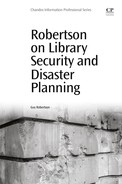Book Description
Robertson on Library Security and Disaster Planning presents a collection of highly-cited, author published articles on security and disaster planning for libraries.
The book represents the only place where these articles are compiled, making it a go-to volume for practitioners. It includes topics covering all aspects of preparation and response, along with articles drawn from library journals, including Feliciter, Canadian Insurance, Disaster Recovery Journal, and Canadian Bookseller.
The book represents a wealth of the author's experience and expertise garnered during a distinguished career working with significant institutions on both their current security problems and their plans for future security.
- Offers a unique and valuable collection of the author's articles on library security and disaster planning
- Accompanies, and complements, Disaster Planning for Libraries, a second title by the author
- Presents a range of security and disaster planning topics in an accessible, narrative style
- Represents the only resource that contains such a broad range of security and disaster planning topics
